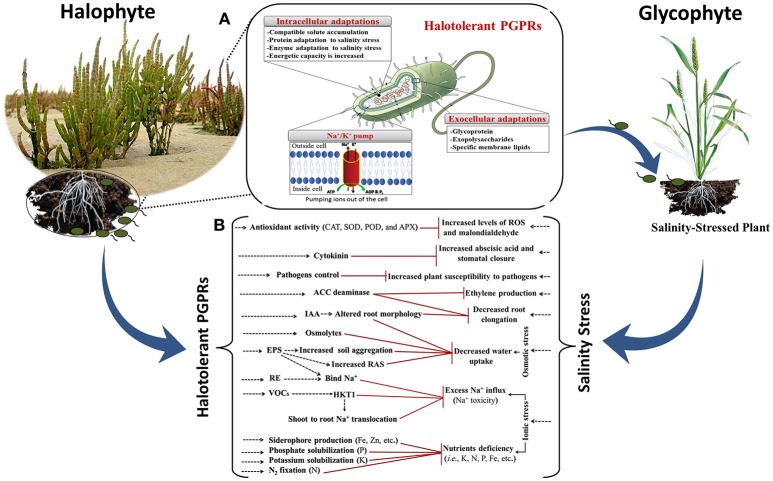Figure 2.
(A) Schematic overview of the mechanisms developed by halotolerant plant growth promoting rhizobacteria (PGPRs) to live and survive in highly salinity conditions. For more details, see this reference (Ruppel et al., 2013). (B), Beneficial attributes of halotolerant PGPRs toward salinity stress tolerance in non-halophyte crops grown in saline soils. Red arrows indicate rhizobacterial components negating salinity stress effects. Halotolerant PGPRs increase the K+/Na+ ratio by selectively enhancing K+ uptake and avoiding translocation of toxic Na+ under saline conditions. These bacteria are capable of increasing the antioxidative systems in plants for reactive oxygen species (ROS) scavenging such as enzymatic components of superoxide dismutase (SOD), catalase (CAT), ascorbate peroxidase (APX), peroxidase (POD), and glutathione reductase (GR) and non-enzymatic components of cysteine, glutathione and ascorbicacid. 1-aminocyclopropane-1-carboxylate (ACC)-deaminase producing PGPRs decrease the excessive ethylene production in plants caused by salinity stress and thereby eliminate the negative effect of ethylene on roots. Production of phytohormones increases the overall growth and also alters root characteristics (i.e., alteration of root proliferation, metabolism and respiration rate) to facilitate uptake of water and nutrients. Phytohormone indole-3-acetic acid (IAA) also increases the size of aerial parts of the plants. Production of osmoprotectants (i.e., proline, polyamines, glutamate, total free amino acids, etc.) by PGPR also contributes to salinity stress tolerance in PGPRs-inoculated plants. Exopolysaccharides (EPS) bind the toxic Na+ and restrict Na+ influx into roots. Soil aggregation due to production of EPS or alteration of root exudates (RE) hydrates the rhizosphere and helps in enhancing uptake of water and nutrients. EPS also increase root adhering-soil (RAS). Volatile organic compounds (VOCs) can trigger induction of high affinity K+ transporter (HKT1) in shoots and reduction of HKT1 in roots, limiting Na+ entry into roots and facilitating shoot-to-root Na+ recirculation. For more details, see these references (Dutta and Khurana, 2015; Kaushal and Wani, 2016; Qin et al., 2016; Sáenz-Mata et al., 2016).

